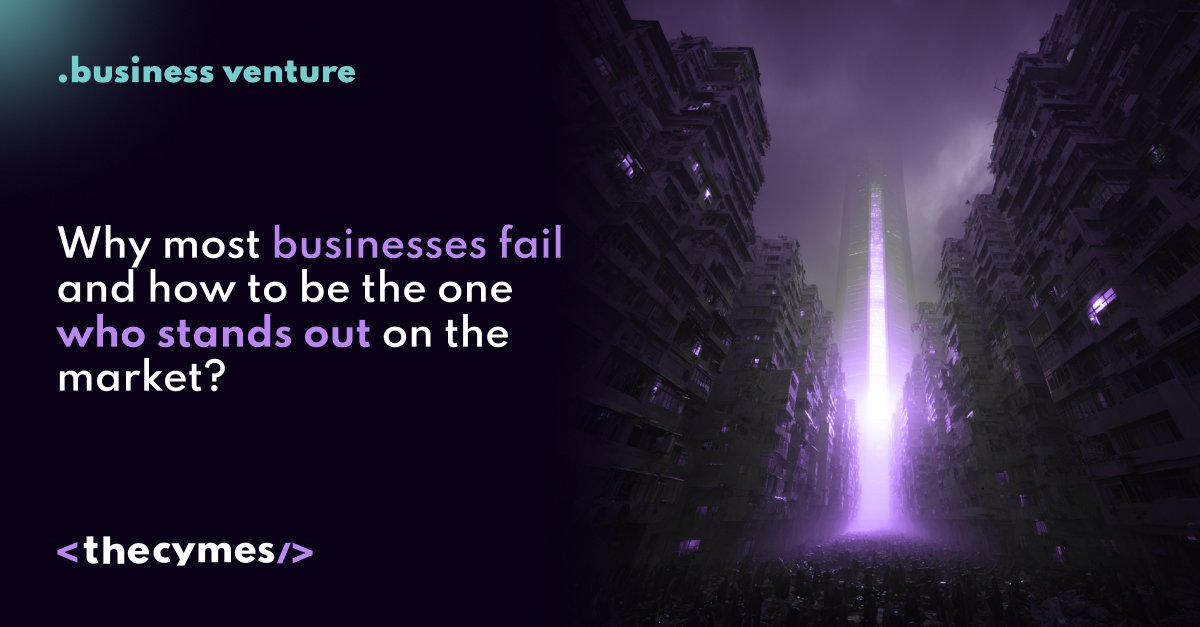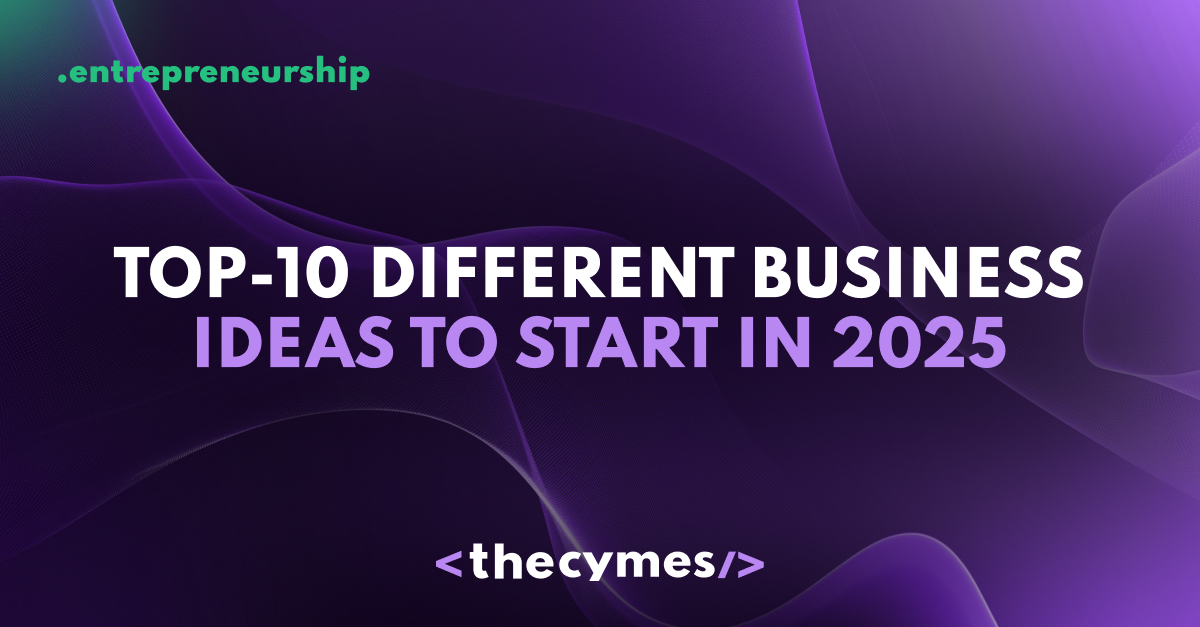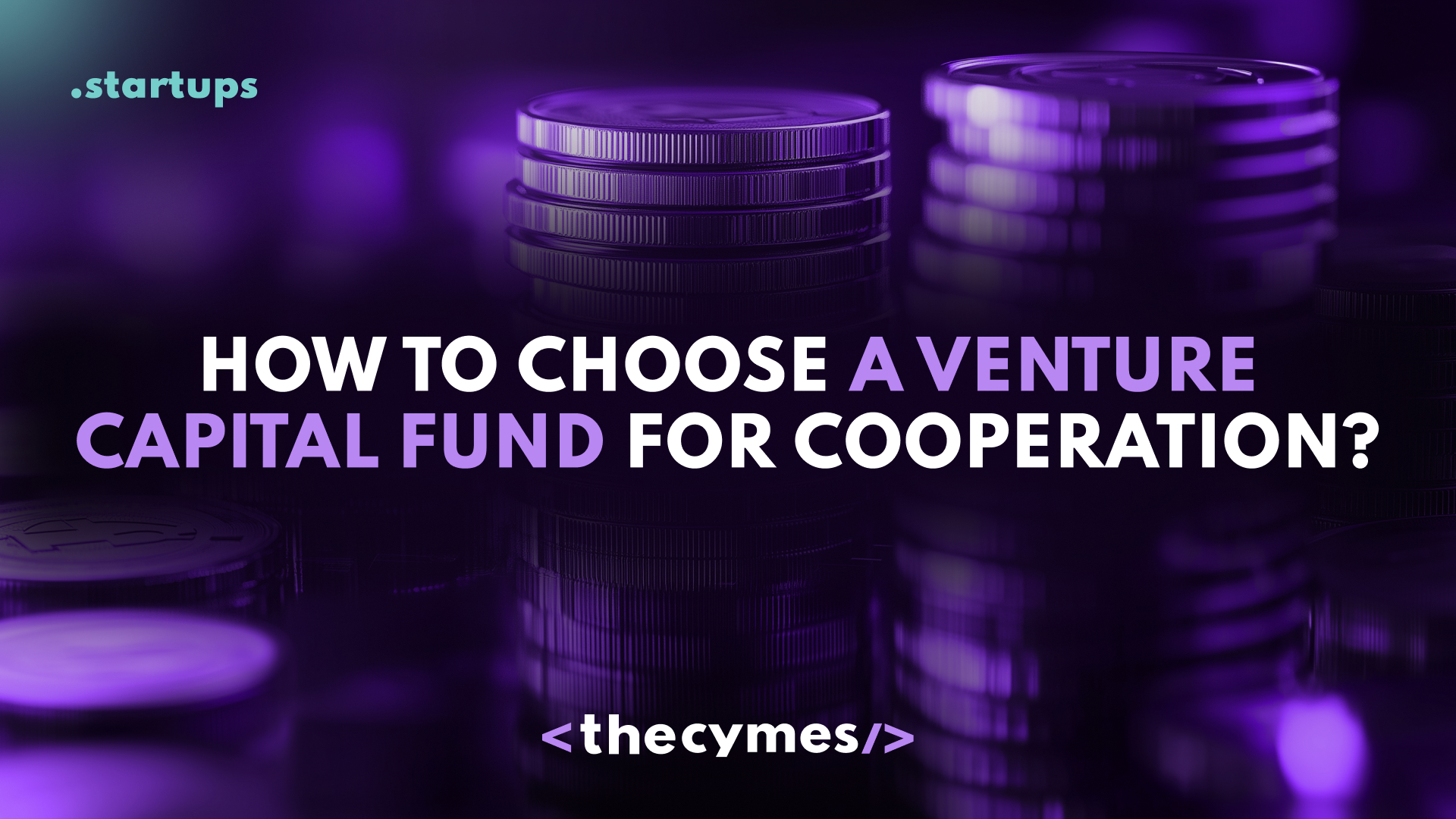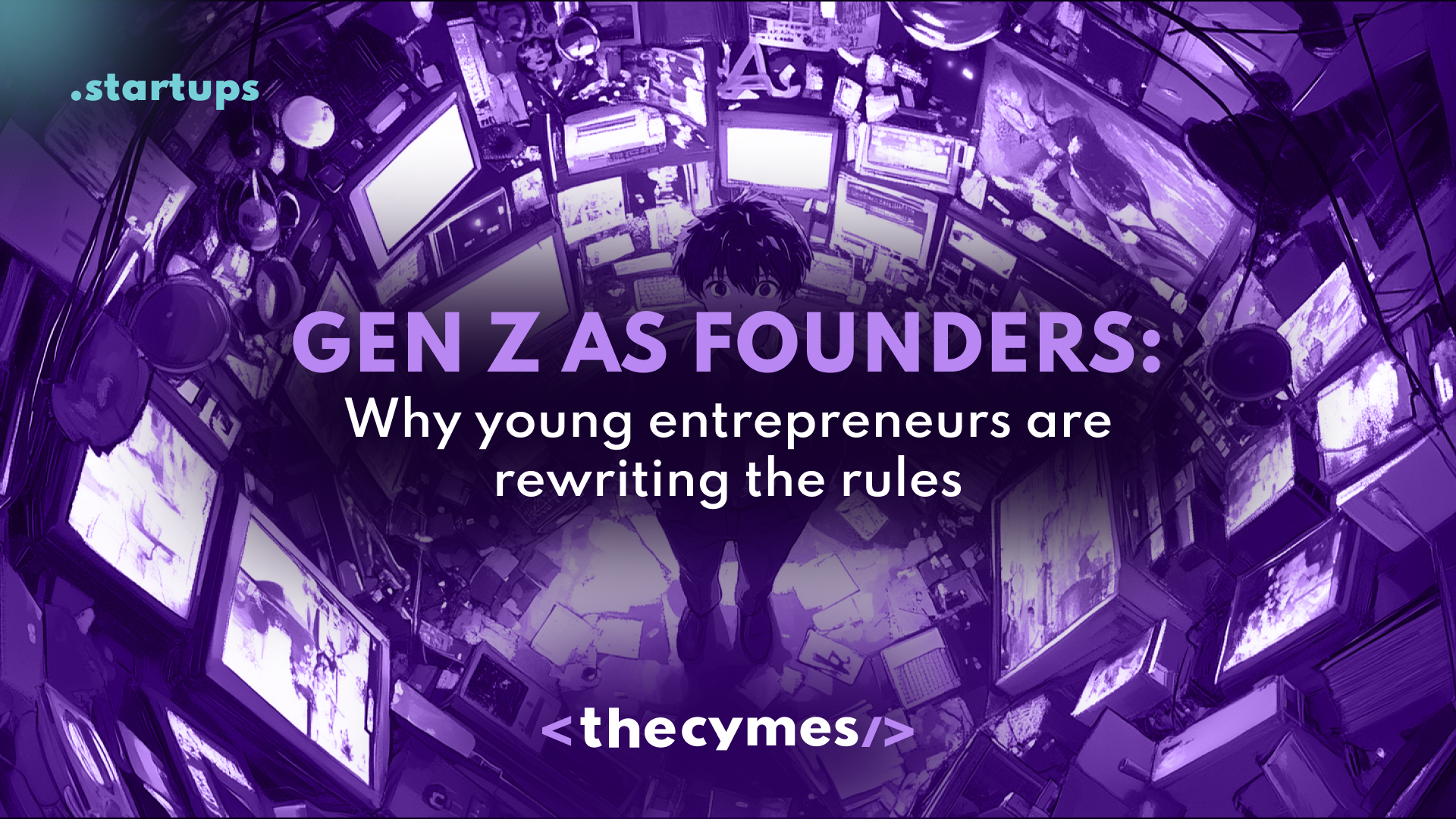Table of Content
Why most businesses fail and how to be the one who stands out on the market?
/>Research shows that most startups fail not because of fate, but because of predictable mistakes. Here's how to avoid them.Rules of startup survival: How to become a winner
The brutal truth of the numbers
When young entrepreneurs present their ideas at Demo Day with burning eyes, few mention the disappointing statistics: 75% of startups close before they become profitable. According to the Angel Investment Network, even those that have received seed capital often fail.
But the good news is that failure is not fatal. It is mostly the result of specific mistakes that can be foreseen and avoided.
Anatomy of failures: What the research says
A consortium of analytical companies, CB Insights та DesignRush, conducted a large-scale study, interviewing hundreds of founders of closed startups. The results are impressive:
Top 6 reasons for startup failure:
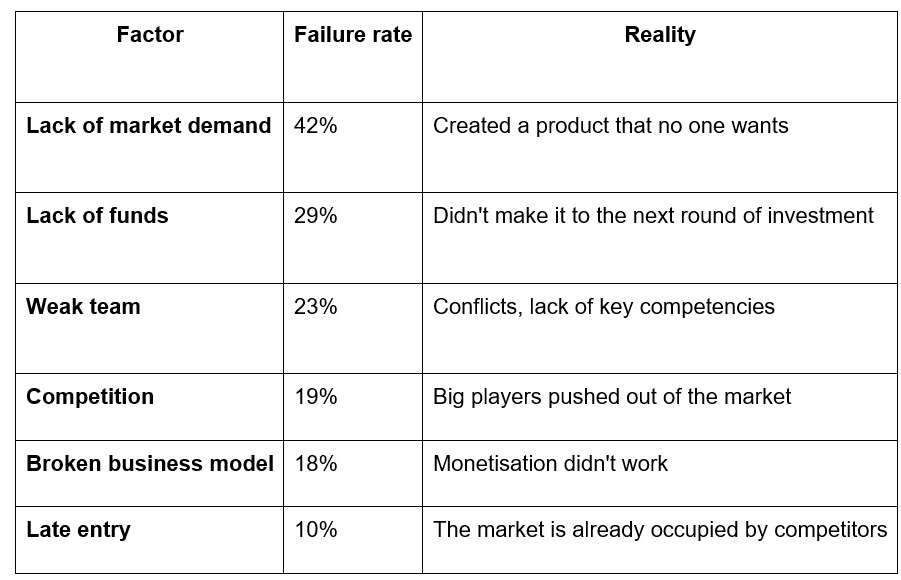
Real stories from the ‘startup graveyard’
Quibi
The story of Quibi is a masterclass in how even billions of dollars in investment cannot save you from a fundamental mistake in understanding the market. Jeffrey Katzenberg, a legendary Hollywood producer, and Meg Whitman, the former CEO of eBay, created a streaming service with a revolutionary idea: short TV series to be watched on mobile phones. The concept seemed perfect - quality content in the format of 10-minute episodes for the TikTok generation. They raised an incredible $1.75 billion from Silicon Valley's top investors and signed A-list stars including Jennifer Lopez and Steven Spielberg.
But the reality was brutal. Users simply didn't want to pay $5-8 per month for content that they could only watch on their phones. The COVID-19 pandemic added to the irony - people were sitting at home with big screens, and Quibi insisted on a mobile format. Six months after the launch, the service closed, losing almost all of its investments. The founder later admitted: ‘We created a product for a market that existed only in our imagination.’
Theranos
The Theranos tragedy has become a symbol of how far a startup can go on promises alone. Elizabeth Holmes, a 19-year-old Stanford student, dropped out of school for the idea of revolutionising medical tests. She promised that their technology could perform hundreds of tests from a single drop of blood. The board of directors was impressive - former Secretaries of State Henry Kissinger and George Shultz, General James Mattis. The company reached a peak valuation of $9 billion, and Holmes became the youngest female billionaire in history.
There was only one problem: the technology didn't work. Edison's machines, which were supposed to be the heart of the revolution, gave inaccurate results, and the company had been using conventional equipment for years, diluting tiny blood samples to the right volumes. When the truth came out thanks to whistleblowers and investigative reporting by the Wall Street Journal, Holmes was convicted of fraud and sentenced to 11 years in prison. Thousands of patients were misdiagnosed, and trust in biotech start-ups was undermined for years.
Color
Color represents a different kind of failure - a product in search of a problem. Bill Nguyen, a serial entrepreneur who had previously sold his company Lala to Apple, raised $41 million before the app was even released. The idea seemed innovative - geolocation-based photo-sharing, where people could share photos with those in their vicinity. Silicon Valley investors were excited about the team and the technical solution.
But when Color launched in 2011, users greeted it coldly. The app was confusing, the purpose was unclear, and most importantly, Instagram already existed and made photo-sharing simple and straightforward. People didn't understand why they should share photos with strangers who happened to be nearby. The team tried to change the concept several times, turning the app into a group photo platform, then a live streaming tool, but nothing worked. Four years later, Color closed down, burning through almost all of its investments and becoming an example of how big money and a talented team cannot compensate for the lack of a real market need.
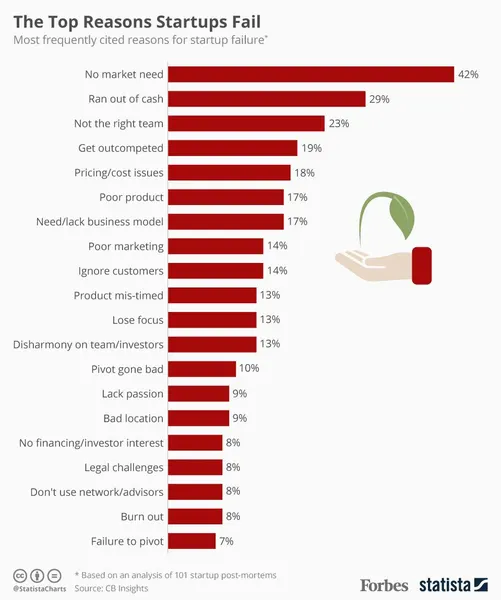
Secrets of the Survivors
Case Study 1: Airbnb
October 2007, San Francisco. Brian Chesky and Joe Gebbia, two young designers, faced a commonplace problem - they didn't have enough money to rent an apartment. A major design conference was taking place in the city, all the hotels were booked, and the prices were going through the roof. The friends decided to rent out places to sleep right in their apartment, laying out three air mattresses and promising a home-cooked breakfast. They called the service AirBed&Breakfast - literally ‘air bed and breakfast’.
The first guests were found through a simple website. Three brave souls paid $80 a night - a young woman from Boston, a 35-year-old man from Utah, and a pensioner from India. This was a turning point: the founders realised that people were willing to sleep in other people's homes if it was cheaper and more authentic than hotels. Moreover, the hosts and guests really enjoyed communicating with each other.
Quick hypothesis validation was the key to Airbnb's success. Instead of spending years developing a complex platform, the founders started with a minimal product - a simple website with photos and a booking form. Every time someone complained about an inconvenience or suggested a new feature, the team responded immediately. They personally met with the first hosts, took photos of their apartments, and even cleaned the accommodation to make it more attractive to guests.
The search for the perfect business model lasted almost a year. At first, they charged a flat fee for listings, then tried a subscription model, but none of them worked. The breakthrough came when they introduced a commission from each booking - 3% from hosts and 6-12% from guests. This way, Airbnb earned money only when it created value for both parties.
Building a strong team turned out to be just as important as the product. Cesky focused on the company's vision and culture, Gebbia headed up design and user experience, and the third co-founder, Nathan Blecharczyk, became CTO. They were looking for people who shared their values - creating a world where everyone can feel at home anywhere in the world.
Today, Airbnb is worth over $70 billion and has changed the travel industry forever. The company has survived the 2008 financial crisis, numerous regulatory challenges, and even the COVID-19 pandemic, which wiped out 80% of bookings in a matter of weeks. The secret of sustainability is constant adaptation and sincere concern for the needs of users.
An interesting fact about survival in the early days: when money was sorely lacking, the founders created limited edition Obama O's and Cap'n McCain's breakfast cereals during the 2008 presidential election. They sold for $40 per box and raised $30,000, which allowed them to survive for several critical months. Later, investor Paul Graham said that it was this ingenuity and unwavering will to survive that convinced him to invest in the team.
Case 2: Dropbox
The story of Dropbox began with the personal frustration of Drew Houston, an MIT student. He was constantly forgetting his USB stick at home when he went to university, or taking the wrong stick that didn't have the files he needed. In 2007, cloud storage was virtually non-existent - Google Drive would appear only five years later, and iCloud would be launched four years later. Most people carried files on flash drives or sent themselves emails with attachments.
Houston decided to create a service that would automatically synchronize files between all the user's devices. The idea seemed simple, but the technical implementation was complex - it needed to ensure stable synchronisation, conflict resolution, and data security. Instead of developing the product in secret for years, Houston created a simple demo video to show how Dropbox works. The video gained millions of views, and the waiting list grew by 75,000 potential users overnight.
Dropbox's ingenious growth strategy was based on the natural virality of the product. When a user shared a folder with a colleague or friend, the latter automatically learned about the service. But the real breakthrough was the referral programme - for every friend invited, both users received an additional 500 MB of free storage. This simple mechanic turned every satisfied customer into an active promoter.
Dropbox's freemium model was carefully thought out. The free 2 GB was enough for the basic needs of most users, but active users quickly reached the limit and switched to paid plans. Unlike competitors who offered huge volumes cheaply, Dropbox focused on service quality and ease of use.
The result is impressive: in 15 months, Dropbox grew from zero to 4 million users with virtually no traditional advertising costs. More than 35% of new registrations came through the referral programme. Today, Dropbox has over 700 million registered users and generates over $2 billion in annual revenue
Case 3: WhatsApp
The story of WhatsApp began with rejection. Brian Acton, an experienced engineer at Yahoo!, applied for jobs at Facebook and Twitter in 2009 but was rejected by both companies. Instead of getting discouraged, he teamed up with his former Yahoo! colleague Jan Koum, a Ukrainian immigrant who came to the US at 16 and taught himself programming.
Koum had a personal motivation to create the messenger. He grew up in the USSR, where phone calls were tapped, so he valued privacy above all else. Their principle was simple: "No advertising, no games, no tricks. Only fast, reliable messages." This minimalist approach was very different from the messengers of the time, which were trying to become social platforms with a lot of additional features.
WhatsApp's unique approach was the complete absence of marketing. They didn't buy ads, hire PR agencies, or even have official social media accounts. Instead, the team focused exclusively on product quality - messages had to be delivered instantly and reliably, the interface had to be intuitive, and the app had to consume minimal battery and traffic.
The business model was revolutionary, simple - a $1 per year subscription after a free year of use. No ads, no premium features, no in-app purchases. Users paid for a product they actually valued, rather than being a commodity sold to advertisers.
The result exceeded the wildest expectations. WhatsApp reached 400 million active users with a team of only 55 employees. In 2014, Facebook acquired the service for $19 billion, the most expensive purchase in the history of social media at the time. It's ironic: Acton, who was rejected by Facebook at the interview, became one of the richest people in Silicon Valley. Koum left Facebook in 2018 due to disagreements over the monetisation of WhatsApp, remaining true to his privacy principles.
A practical survival plan: A step-by-step guide
Stage 1: Idea validation (0-3 months)
Test 1:
- Tell 20 potential customers about the problem (not the solution!)
- If fewer than 15 say ‘Oh yeah, that's a terrible problem!’, the idea is weak
Money test:
- Offer a pre-order for 10-20% of the cost of the future product
- At least 30% should agree to pay
Validation tools:
- Landing page with product description and ‘Buy’ button
- Google Ads for $100 to test demand
- Social media surveys
- Interviews with 50+ potential users
Stage 2: MVP and first customers (3-9 months)
The 80/20 rule: Your MVP should solve 80% of the problem with 20% of the functionality.
An example of the right MVP:
- Buffer - a simple app for scheduling social media posts
- Only one feature, but it solves a specific problem
- Launched in 7 weeks, $1000 budget
Anti-example:
- A startup tries to make a ‘Facebook for pets’ with 15 features at once
- 18 months of development, $500K in costs
- Users don't understand why it's needed
Stage 3: Product-Market Fit (9-18 months)
PMF metrics:
- 40% of users would say they would be ‘very upset’ if the product disappeared
- NPS > 50 (Net Promoter Score)
- Organic growth - at least 20% of new users come from recommendations
PMF signals:
- Customers themselves suggest new features
- Growth without marketing costs
- Difficult to sustain demand
Stage 4: Attracting investment
What investors want to see:
Traction:
- Revenue growth of 20%+ per month
- Low churn rate (<5% per month for B2B)
- Specific case studies of successful customers
Team:
- Complementary skills (tech + business + sales)
- Experience working together
- Committed full-time
Market:
- TAM > $1bn (Total Addressable Market)
- Market growth 10%+ annually
- Opportunity to become #1-2 in the niche
Tools and resources for founders
Free validation tools:
Market research:
- Google Trends - query popularity
- SimilarWeb - competitor analysis
- Facebook Audience Insights - target audience size
MVP creation:
- Webflow, Bubble - no-code platforms
- Figma - design and prototyping
- Typeform - surveys and application collection
Analytics:
- Google Analytics - up to 10M hits for free
- Mixpanel - user behaviour
- Hotjar - heatmaps and session recordings
The formula for getting to the top
Success in the startup ecosystem is not about luck or magic, but about systematic work, endurance, and adaptability. Failure stories in 75% of cases are a mirror of typical mistakes: a weak market, insufficient understanding of the client, too slow a response, or, on the contrary, unreasonable scaling. But there is another way.
Startups that are part of the lucky 25% are built on completely different principles. These are teams that are not just passionate about the product, but understand the real pain of the market. They are ready to test their assumptions quickly and painfully. They maintain financial discipline not only on the pitch deck but also in their daily decisions. These are the ones who know how to turn around in time, change their focus, and say no to functionality that does not bring value.
The main lesson is simple: a startup is not a romantic adventure, but a project with high pressure and a small amount of time. An idea without quality execution is worthless. But if you have a team that knows how to listen to the client, calculate costs, and change the strategy, the chance of success increases significantly.
Even if the result is not in numbers but in skills, this path will still make sense. Everything you put into this experience will come back: in a new project, a new role, or a new company.
Don't be afraid of failure - be afraid of not trying.
